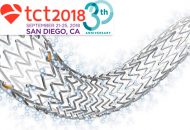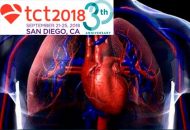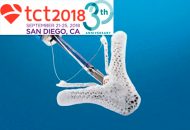Angina pectoris without stenosis in the epicardial coronary arteries is a common problem with several possible underlying causes. The main purpose of this work was to test the hypothesis that stratified medical therapy guided by an interventional diagnostic procedure might improve outcomes. Patients without coronary lesions and with angina were immediately randomized 1:1 to an…
TCT 2018 | ABSORB IV: Much Life Left for Bioresorbable Scaffolds
Previous studies have documented higher rates of adverse events with bioresorbable scaffolds (ABSORB) compared with metallic drug-eluting stents (DES). However, these studies included lesions smaller than recommended for these scaffolds and a suboptimal implantation technique. The ABSORB IV study, presented by Dr. Stone at TCT 2018 and published simultaneously in The Lancet, randomized patients to polymeric everolimus-eluting scaffold Absorb…
TCT 2018 | OAC-ALONE: Anticoagulation Alone 1 Year After Stenting in Patients with Atrial Fibrillation
Up to now, there had been no randomized controlled trial assessing oral anticoagulation alone vs. oral anticoagulation plus antiplatelet therapy in patients with atrial fibrillation 1 year after stenting in a setting of stable coronary disease. Such was the vacuum that this work, presented at TCT 2018 and published simultaneously in Circulation, attempted to fill. This trial…
TCT 2018 | LRP: Infrared Technology for the Detection of Vulnerable Patients and Plaques
Despite optimal medical treatment and modification of risk factors, patients may spend long periods without symptoms and then experience acute coronary syndrome without any prior indication that may allow us to predict the time of occurrence. This is why the possibility of detecting patients with vulnerable plaques and who are at higher risk is very…
TCT 2018 | FAST-FFR: Angiography-Derived FFR Without Hyperemic Stimulus or Invasive Guidewire Placement
All over the world, functional lesion measurement remains underutilized due to the need for a hyperemic stimulus (which may be avoided with instantaneous wave-free ratio [iFR]) and, above all, the invasiveness of guidewire placement (crossing the intended lesion) for the measurement. These guidewires have improved a lot, but they still lack the navigating capacity of…
TCT 2018 | Mismatch After TAVR According to the TVT Registry
Prosthesis-patient mismatch (i.e. a difference between the size of the implanted prosthetic valve and the patient body size) in patients who undergo surgery is associated with worse outcomes. This may also apply to percutaneous prostheses, although that has not been well-studied yet. This work, presented at TCT 2018 and published simultaneously in JACC, analyzes this problem…
TCT 2018 | ReCre8 Trial: Permanent Polymer and Zotarolimus vs. Polymer-Free Amphilimus
Polymer-free amphilimus-eluting stents are a novel technology combining sirolimus and long-chained fatty acids. This enhances the uptake of antiproliferative agents and may be associated with lower restenosis, particularly among patients with diabetes. The new device includes abluminal reservoirs filled with the drug; in consequence, there is no need for polymer. This work compares this new…
TCT 2018 | PADN-5: Pulmonary Artery Denervation in Pre- and Post-Capillary Pulmonary Hypertension
This work included 98 patients with pre- and post-capillary pulmonary hypertension defined as mean pulmonary arterial pressures ≥25 mmHg, pulmonary capillary wedge pressures >15 mmHg, and pulmonary vascular resistance >3.0 Wood units. These subjects were randomized to pulmonary artery denervation vs. sildenafil plus sham pulmonary artery denervation. The medical treatment for heart failure was administered to all patients. The…
TCT 2018 | COAPT: MitraClip in Patients with Secondary Mitral Regurgitation
The prognosis of patients with heart failure and mitral regurgitation secondary to ventricular dysfunction and dilation is guarded. Percutaneous mitral valve treatment of these patients may at least improve their symptoms. This study was conducted in 78 sites in the United States and Canada, and included patients with moderate-to-severe (3+) or severe (4+) mitral regurgitation who…
TCT 2018 | BIONYX: Durable Polymer-Coated vs. Ultrathin-Strut, Bioresorbable Polymer-Coated DES
This work, presented at TCT 2018 and published simultaneously in The Lancet, is the first randomized study comparing a zotarolimus-eluting stent with a new thin-strut structure and limited radiographic visibility (Onyx), and a bioresorbable polymer-coated sirolimus-eluting stent (Orsiro). Onyx was developed to improve visibility while reducing strut thickness. To that end, a dense platinum–iridium core and…
TCT 2018 | TriValve: Mitraclip for the Tricuspid Valve
The TriValve is a multicenter, international and retrospective study of multiple devices for percutaneous intervention to treat cardiac failure. This is a sub-analysis of patients receiving the most conventional of these devices: the MitraClip. The main points assessed by this study were all cause mortality, unplanned hospitalizations, functional class, the presence of peripheral edema, and…










